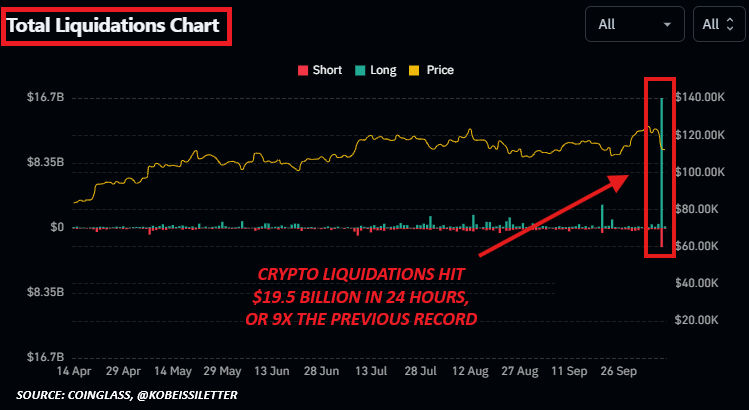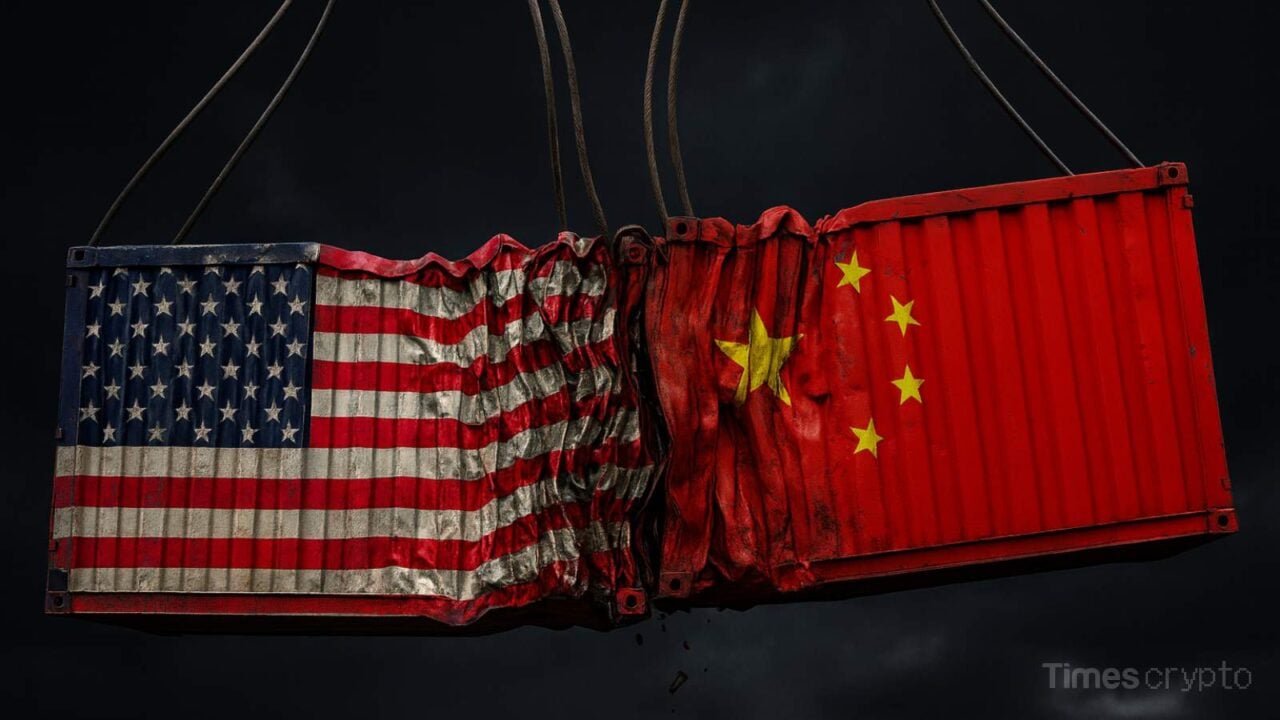U.S. President Donald Trump threatened the global financial market on the weekend with the announcement of extensive new tariffs on Chinese imports. The announcement of a new trade war with a full arsenal sent shockwaves to the crypto market. The move, coupled with China’s pledge to retaliate, led to the most violent liquidations in crypto history with over $19 billion liquidated and 1.6 million traders affected.
Crypto Market Faces Largest Liquidation in History Amid Turmoil

Singapore-based trading firm QCP Capital said in its weekend report that “markets were thrown into turmoil overnight after an unexpected escalation in US-China tensions.” The firm noted that the sell-off began after Trump accused Beijing of attempting to “hold the world captive” through wide-ranging export controls on rare earth elements and related materials. Within hours, the White House announced a 100% tariff on all Chinese imports along with new export restrictions targeting critical software.
According to QCP, China had already distributed formal letters to several nations detailing new export limits that will take effect on November 1, covering “a wide range of industrial inputs.” These restrictions marked the latest escalation in the geopolitical and trade standoff between the world’s two largest economies.
The renewed tensions triggered a sharp global risk-off move. U.S. equities plunged, with the Nasdaq falling 3.5% and the S&P 500 down 2.7%. The impact rippled swiftly through crypto markets. Bitcoin briefly collapsed to $102,000 before recovering to $112,000 as nearly $19 billion worth of leveraged positions were liquidated, which is the largest single-day liquidation event ever recorded in the digital asset market.
“BTC plunged to $102K before rebounding to $112K, as an estimated $19 billion in leveraged positions were liquidated,” QCP’s report stated. It added that short-dated volatility surged, with “1-week BTC ATM implied vols spiking to 98 before easing back to around 50 vols as markets stabilized.”
While most exchanges experienced steep but orderly declines, Binance appeared to bear the brunt of the turmoil. Prices on the world’s largest crypto exchange showed extreme dislocations, with stablecoin USDe collapsing to $0.65, wrapped Ethereum token wBETH trading nearly 90% below parity, and BNSOL dropping over 80%.“
Attention quickly turned to Binance, where the most extreme dislocations occurred,” QCP wrote. “Market makers withdrew liquidity, amplifying the price spiral.” Traders and analysts have since raised suspicions that the sell-off on Binance may have been worsened by an exploit. Evidence circulating among market participants “hints at a possible coordinated exploit of Binance’s pricing systems during the market chaos,” QCP noted. Here, they referenced that the exchange had announced scheduled system updates for USDe, wBETH, and BNSOL just days before the crash. The firm said the “targeted sequence of selloffs” suggested potential manipulation aimed at forcing cascading liquidations.
As global markets absorbed the shock, U.S. Vice President JD Vance attempted to calm nerves late in the session, saying the administration remained open to “reasonable negotiation” with Beijing. His comments helped steady sentiment going into the Asia open, though QCP warned that “policy risk remains elevated and liquidity thin.”
In a follow-up message on its Telegram channel titled “QCP Asia Colour – 13 Oct 2025,” the firm summarized the event as a “Crypto Meltdown.” It said: “Markets sold off sharply overnight after a surprise escalation in US-China tensions. Trump announced 100% tariffs on Chinese imports following China’s new export restrictions on rare earths, sparking a global risk-off rout.”
How Will China’s Retaliation Affect Crypto Market?
The message added that Binance saw “severe dislocations” and that “traders suspect a possible coordinated exploit.” The firm ended its note with a question still lingering over global markets: “Will Beijing retaliate and reignite another wave of volatility?”
That retaliation appears imminent. On Sunday, China’s Ministry of Commerce issued a strongly worded statement blaming Washington for the escalating tensions. “Wilful threats of high tariffs are not the right way to get along with China,” a ministry spokesperson said via the state-run Xinhua news agency. They added, “China’s position on the trade war is consistent. We do not want it, but we are not afraid of it. If the United States insists on going the wrong way, China will surely take resolute measures to protect its legitimate rights and interests.”
Beijing’s comments came as U.S. stock futures pointed to another sharp decline at Monday’s open. Dow Jones futures were down 887 points, building on Friday’s 879-point drop, which erased nearly $2 trillion in market value. Despite the market turmoil, Trump struck a more conciliatory tone in a Sunday post on Truth Social.
“Don’t worry about China, it will all be fine! Highly respected President Xi just had a bad moment. He doesn’t want Depression for his country, and neither do I. The U.S.A. wants to help China, not hurt it!!!” he wrote. The message marked a notable shift from his earlier stance. On Friday, Trump had accused Beijing of taking an “extraordinarily aggressive” approach through rare-earth export controls and announced that his administration would impose 100% tariffs on all Chinese goods starting November 1. He also said the U.S. would introduce new export controls on critical software products the same day.
The president’s initial post had set off widespread fear that the world could be heading into another severe round of trade hostilities reminiscent of the 2018-2019 tariff battles. QCP said that such policy risks “keep market positioning defensive across risk assets heading into the new week.”
The fallout extended beyond crypto. Investors dumped equities and commodities, while the U.S. dollar and Treasury yields surged as traders rushed into safe-haven assets. Bitcoin’s sharp rebound late Sunday reflected a modest return of risk appetite following Trump’s softer remarks, but analysts warned that sentiment remains fragile. China’s planned restrictions on rare-earth exports, which are essential inputs for electric vehicles, semiconductors, and renewable energy components, are expected to have significant downstream effects on global manufacturing.
Meanwhile, Trump’s 100% tariff threat introduces fresh uncertainty for multinational companies and supply chains already stretched by geopolitical tension. As of Monday morning, Bitcoin traded near $113,000, while Ethereum regained the $4,000 mark after plunging more than 9% during Friday’s selloff. Altcoins also rebounded, with BNB, Solana, and XRP recording gains between 7% and 14% as traders hunted for short-term bargains.
While Trump’s weekend message offered some relief to risk markets, investors remain cautious. Both governments have left open the possibility of negotiations but neither has backed away from their respective threats. As QCP put it, “Prices should stabilize for now as markets await China’s response.” For now, with Beijing signaling that retaliation is imminent, crypto traders and global investors alike are bracing for what could be another turbulent week.
Read More: Bitcoin Price Crashes to $105K Amid $2.6B Liquidations, Here’s Why







